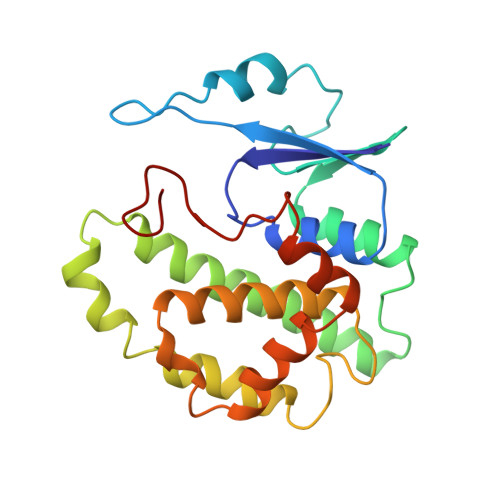First-sphere and second-sphere electrostatic effects in the active site of a class mu gluthathione transferase.
Xiao, G., Liu, S., Ji, X., Johnson, W.W., Chen, J., Parsons, J.F., Stevens, W.J., Gilliland, G.L., Armstrong, R.N.(1996) Biochemistry 35: 4753-4765
- PubMed: 8664265
- DOI: https://doi.org/10.1021/bi960189k
- Primary Citation of Related Structures:
6GST, 6GSU, 6GSV, 6GSW, 6GSX, 6GSY - PubMed Abstract:
The activation of the thiol of glutathione (GSH) bound in the active site of the class mu glutathione transferase M1-1 from rat involves a hydrogen-bonding network that includes a direct (first-sphere) interaction between the hydroxyl group of Y6 and the sulfur of GSH and second-sphere interactions involving a hydrogen bond between the main-chain amide N-H of L12 and the hydroxyl group of Y6 and an on-face hydrogen bond between the hydroxyl group of T13 and the pi-electron cloud of Y6 (i.e., T13-OH---pi-Y6-OH--- -SG). The functions of these hydrogen bonds have been examined with a combination of site-specific mutagenesis and X-ray crystallography. The hydroxyl group of Y6 has a normal pKa of about 10 even though it is shielded from solvent and is in a largely hydrophobic environment. The apparent pKa of GSH in the binary Y6F.GSH complex is increased by 1.6 log units, and the reactivity of the enzyme-bound nucleophile is reduced. The catalytic properties of the Y6L mutant are identical to those of Y6F, suggesting that the weakly polar on-edge interaction between the aromatic ring and sulfur has no influence on catalysis. The refined three-dimensional structure of the Y6F mutant in complex with GSH shows no major structural perturbation of the protein other than a change in the coordination environment of the sulfur. Removal of the second-sphere influence of the on-face hydrogen bond between the hydroxyl groups T13 as in the T13V and T13A mutants elevates the pKa of enzyme-bound GSH by about 0.7 pKa units. Crystal structures of these mutants show that structural changes in the active site are minor and suggest that the changes in pKa of E.GSH are due to the presence or absence of the on-face hydrogen bond. The T13S mutant has a completely different side-chain hydrogen-bonding geometry than T13 in the native enzyme and catalytic properties similar to the T13A and T13V mutants consistent with the absence of an on-face hydrogen bond. The gamma-methyl group of T13 is essential in enforcing the on-face hydrogen bond geometry and preventing the hydroxyl group from forming more favorable conventional hydrogen bonds.
Organizational Affiliation:
Department of Chemistry and Biochemistry, University of Maryland, College Park, Md, 20742, USA.















